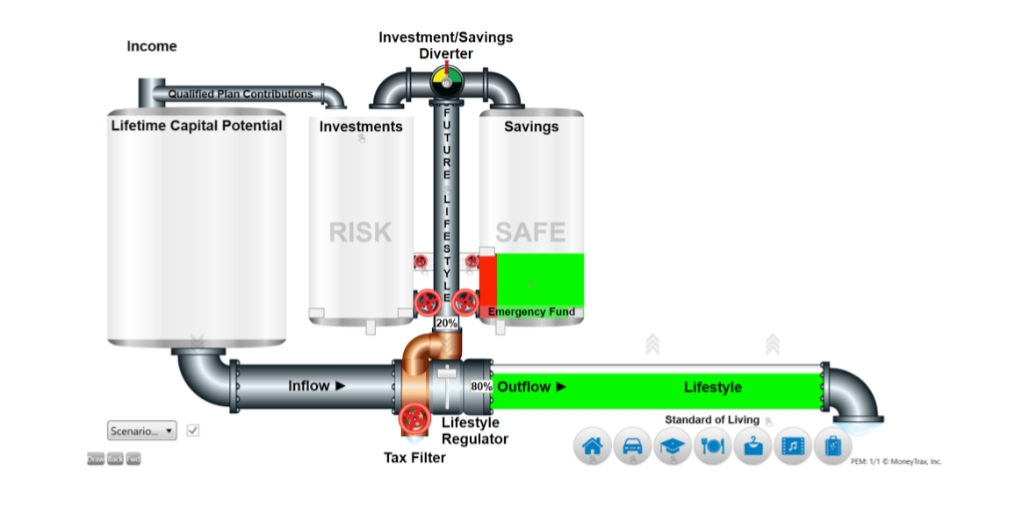
If you’re like most parents, you have a never-ending list of things you want to teach your child so they grow up to be a successful adult who contributes to society. From a young age, you model and instruct them in how to share, what respect looks like, and how to handle responsibility. But do you have a plan for how you are going to teach your kids about money?
Teaching our kids anything often comes from a place of learning from our own experiences and hoping that we can help them avoid the same mistakes we made. Sometimes what we have done wrong as parents, can serve to be a strong teaching moment for our kids. Along with sharing wisdom and practical lessons about budgeting, saving, and building credit, the best thing I taught my kids about money is the value of having a “safe bucket.”
Security For The Unexpected
As much as we wish we could predict the future, our lives rarely go exactly as planned. But just because we don’t know what twists and turns life will take doesn’t mean we can’t prepare for them. Through my own personal experience and mistakes, as well as those of my clients, I have found that having a “safe bucket” or an emergency fund can provide a cushion through ups and downs and protect your other financial assets.
Unfortunately, most Americans don’t have an easily accessible savings account with enough cash to cushion a financial blow. In fact, nearly 60% of Americans would not be able to cover a $500-$1,000 expense. (1)
This is where things get dicey. If you don’t have enough to pay for the unexpected, such as a job loss, a medical bill, car repair, or home disaster, how do you come up with the money? None of the options are ideal. Some people turn to family or friends for help, or some cut their spending. The Transamerica Center For Retirement Studies tells us that 23% of people surveyed dipped into their retirement plan to pay for an unexpected expense. (2) Equally as bad, most people put the bill on their credit card. All of these actions just put you behind financially, adding a loan payment to your budget or high interest to pay off.
Think of it this way: For every $1,000 you have outstanding on your credit card every year, at an interest rate of 23%, you will pay an extra $230 per year of interest that is not tax-deductible. When it comes to paying unnecessary high interest, it’s like withdrawing $230 from the ATM and setting fire to it. Now that you know why you need an emergency fund, how much should you set aside for the unforeseen?
How Much Do You Need?
Sadly, there’s no cut-and-dried amount that everyone should have saved for a rainy day. Just like almost everything else regarding finances, it really depends on your unique situation. While the size of your fund will depend on the size of your family, current debt, and insurance coverage, the general rule of thumb is to have enough to cover three to six months of essential expenses. If your daily living expenses are low, your emergency fund will be less than that of someone who has a high mortgage, more mouths to feed, and lives in a city with a high cost of living.
Additionally, if you know you have a major purchase or life milestone coming up, you may want even more in your savings to give yourself some breathing room. For example, welcoming a new baby into the family may result in medical bills and the temporary loss of income. Or, if you know your car is about to die or your dishwasher needs to be replaced, focus on putting a little more into your liquid savings ahead of time.
If your financial situation is stable, you will need less set aside than someone whose situation is more on edge. If you are in a two-income household, where both partners’ jobs are secure, you could probably get away with three months’ worth of expenses saved. But if you are self- employed, work on commission, or have only been at your current job for a short amount of time, you should lean more towards six months’ worth of expenses in your emergency fund.
If you have an idea of how much you need to save but don’t know where to find those extra dollars, here are some ideas.
Where To Begin
There are so many things to save for on top of all the bills you need to pay. You know you should be maximizing your 401(k) and IRA. You want to put as much as possible towards a college fund for your kids or grandkids. Now you need to find more excess cash to build an emergency fund. The good news is that every little bit will provide a buffer for future crises.
By saving an additional 5%, someone earning $40,000 a year can save $2,000 toward emergencies. You’d be surprised at how lowering your spending on non-essentials can help you come up with the extra savings. Even better, any time you come into unexpected money, put some toward your emergency fund. This could be from a tax refund, a bonus at work, gifts from relatives, or a salary increase.
Remember that an emergency fund is not an investment. It’s a “Safe Tank” that will keep your money liquid and safe from risk. You will never regret having an emergency fund.
Peace Of Mind – LUC
Remember that an emergency fund is not an investment. It’s a “Safe Tank” that will keep your money liquid and safe from risk. You will never regret having an emergency fund. It’s much more than just a financial tool. It’s peace of mind, it’s a better marriage, it’s the ability to take advantage of an opportunity, it’s control in uncontrollable circumstances.
Let Me Help
If I could teach my kids (and all of my clients, for that matter) one thing about money, it would be to invest in a safe bucket. Everyone needs money for the unexpected, so instead of losing sleep every time your car makes a strange sound or a windstorm damages your house, rest easy knowing that you’ve worked hard to mitigate the damage to your budget. It’s better to have an emergency fund and never need it than not to have one and desperately need it. If you would like to discuss your particular situation to get an idea of how an emergency fund would provide you with peace of mind, give me a call at 800-814-8742 or email dcoen@sageviewadvisory.com.
About Dave
Dave Coen is a Financial Advisor with SageView Advisory and the CEO of College Planning America. Along with his retirement financial industry experience, he is a College Planning Specialist. He works closely with individuals and families to provide them comprehensive financial planning that addresses all elements of their financial picture. Learn more by connecting with Dave on LinkedIn.
1920 Main Street, Suite 800, Irvine, CA 92614 Tel: 800-814-8742
Registered Representative with and securities offered through Cetera Advisor Networks LLC (doing insurance business in CA as CFGAN insurance agency), Member FINRA/SIPC. Advisory services offered through SageView advisory group, LLC. Cetera is under separate ownership from any other named entity. CA insurance license #0G82578
_________
(1) https://money.cnn.com/2017/01/12/pf/americans-lack-of-savings/
(2) https://www.transamericacenter.org/docs/default-source/resources/center-research/16th- annual/tcrs2015_sr_16th_compendium_of_workers.pdf



 Apply for a College Planning America Scholarship
Apply for a College Planning America Scholarship